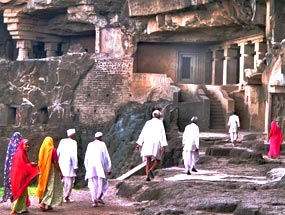Ajanta caves are situated in the Aurangabad
district of Maharashtra. Read on to know more about Ajanta cave
temples of India.
Ajanta Caves

Location: Aurangabad District, Maharashtra
Status: UNESCO World Heritage Site (Since 1983)
Founded In: 2nd century BC
Number of Caves: 29
Represent: Hinayana and the Mahayana sects of Buddhism
Ajanta Caves are rock-cut cave monuments, situated near the Aurangabad
city of Maharashtra. The caves date back to the 2nd century BC and were
declared a UNESCO World Heritage Site in the year 1983. The caves of
Ajanta are adorned with both paintings as well as sculptures, which are
considered to be masterpieces of Buddhist religious art. Located just
outside the Ajintha village of Aurangabad district, the caves lie in a
wooded and jagged ravine, which is almost in the shape of a horseshoe.
As per the Archaeological Survey of India, there are twenty-nine caves
in toto. Ajanta cave temples were excavated from the southern side of
the precipitous scarp, by cutting the ravine. The altitude of the caves
varies from 35 to 110 ft, above the bed of the stream. There are a
number of viharas (monastic halls of residence) and chaitya grihas
(stupa monument halls) inside the Ajanta Caves of India. These viharas
and chaityas grihas were cut into the mountain cliffs in two distinct
phases.
The first phase of the formation of the caves relates to the time when
Hinayana sect of Buddhism was in force. Often referred to as the Lesser
Vehicle of Buddhism, the Hinayana Sect believes in the symbolical
worship of Lord Buddha. Since the sect is not averse of Buddha statues,
one can see a few of them in the caves belonging to the phase of
Hinayana sect, namely cave numbers 9, 10, 12, 13 and 15A. Lord Buddha
has been enshrined in these caves in the form of a stupa or a mound.
Three centuries later, the second phase of cutting out the caves was
carried out on the same site. This phase corresponded with the phase of
the Mahayana sect of Buddhism. Mahayana sect is also known as the
'Greater Vehicle of Buddhism'. This sect is more lenient and encourages
direct cow depiction of Lord Buddha. It is believed that the Mahayana
caves were founded from 462 to 480 CE. Caves number 1, 2, 3, 4, 5, 6, 7,
8, 11, 14, 15, 16, 17, 18, 19, 20, 21, 22, 23, 24, 25, 26, 27, 28, and
29 belong to this phase.
Caves 9 and 10, belonging to the Hinayana phase, are chaitya grihas,
while those numbered 12, 13, and 15A are viharas. Of the caves belonging
to the Mahayana phase, caves 19, 26, and 29 are chaitya grihas, while
the rest, numbered 1, 2, 3, 5, 6, 7, 8, 11, 14, 15, 16, 17, 18, 20, 21,
22, 23, 24, 25, 27 and 28, are viharas. The viharas have varied sizes,
with some of them being as much as 52 feet long. Most of them are of a
square shape and showcase a wide variety as far as ornamentation and
style is concerned.
Some of the viharas have a simple veneer, while some are much more
elaborate; some have a porch, while some are without one. The early
viharas were more like halls of residence and congregation and did not
have shrines. The later ones, however, had shrines in the back walls.
The shrines were built to house the image of the Buddha, often seated in
the 'dharmachakrapravartana' mudra i.e., the teaching mudra. The latest
caves of Ajanta even have sidewalls, along with the porch. Numerous
viharas situated inside the Ajanta cave temples stand adorned with
carvings, along with paintings on the walls and the ceilings.


